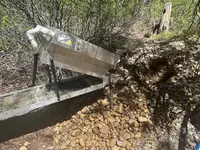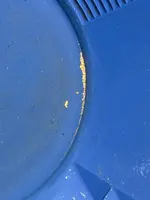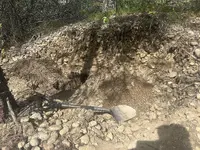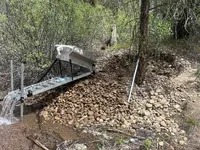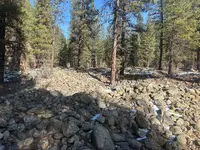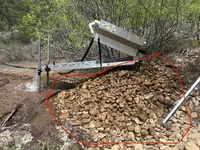I'm curious is anyone has some tips or some info that I haven't thought of. I recently got an 100 acre placer claim in on of the richest sections of the state. The valley is lined with old bucket dredge tailings.
Several local guys were excited about it, with one joking that he would give me $10k if I didn't want it. After a month of working hard sampling I'm wondering if it's been worked dry. An out of state friend said if it's been hydraulically mined, good luck. I'm starting to think he's right. I keep hearing that the old timers only got 30-40% of the gold, but it's sure looking like they got more like 90%+. If they dredged the hell out of it then hydraulically mined the sides of both sides to bedrock I'm wondering if I'm wasting my time. Old pictures make it look like they turned it into a moonscape at the beginning of the 20th century.
I keep hearing how great tailings piles are for detecting but I have not even found the tinniest picker. The piles, the long stretches of old ground sluice...nothing. From my understanding of the dredge, it seems unlikely that gold made it into any of the bigger rock piles, unless it was a massive nugget. If the conveyer took large oversized rocks that were washed and spit them out I can't imagine any smaller gold made it in those. I've dug down in them (bigger rock piles in winrows) after moving a ton of rock and didn't find any color sample panning.
I've ran my high banker on several of the smaller (1-3") rock piles. A few small pickers, but still only 0.1-0.15g an hour. And I have a huge high banker that can handle shoveling as fast as I can into it.
I've tried finding the edges of the dredge workings and dug down into the hillsides. Little to no color. Again, if they used hydraulic mining, am I wasting my time?
I've dredged to bedrock on a bend. Best day was 0.33g.
The gold is not increasing with depth. In fact, I seem to find tiny pickers in the first 1-3' and smaller gold towards the bottom.
So far nothing is even worth the gas and certainly not worth the hard labor. Should I move on, or is there something I'm missing about mining old workings?
Several local guys were excited about it, with one joking that he would give me $10k if I didn't want it. After a month of working hard sampling I'm wondering if it's been worked dry. An out of state friend said if it's been hydraulically mined, good luck. I'm starting to think he's right. I keep hearing that the old timers only got 30-40% of the gold, but it's sure looking like they got more like 90%+. If they dredged the hell out of it then hydraulically mined the sides of both sides to bedrock I'm wondering if I'm wasting my time. Old pictures make it look like they turned it into a moonscape at the beginning of the 20th century.
I keep hearing how great tailings piles are for detecting but I have not even found the tinniest picker. The piles, the long stretches of old ground sluice...nothing. From my understanding of the dredge, it seems unlikely that gold made it into any of the bigger rock piles, unless it was a massive nugget. If the conveyer took large oversized rocks that were washed and spit them out I can't imagine any smaller gold made it in those. I've dug down in them (bigger rock piles in winrows) after moving a ton of rock and didn't find any color sample panning.
I've ran my high banker on several of the smaller (1-3") rock piles. A few small pickers, but still only 0.1-0.15g an hour. And I have a huge high banker that can handle shoveling as fast as I can into it.
I've tried finding the edges of the dredge workings and dug down into the hillsides. Little to no color. Again, if they used hydraulic mining, am I wasting my time?
I've dredged to bedrock on a bend. Best day was 0.33g.
The gold is not increasing with depth. In fact, I seem to find tiny pickers in the first 1-3' and smaller gold towards the bottom.
So far nothing is even worth the gas and certainly not worth the hard labor. Should I move on, or is there something I'm missing about mining old workings?
Upvote
0

